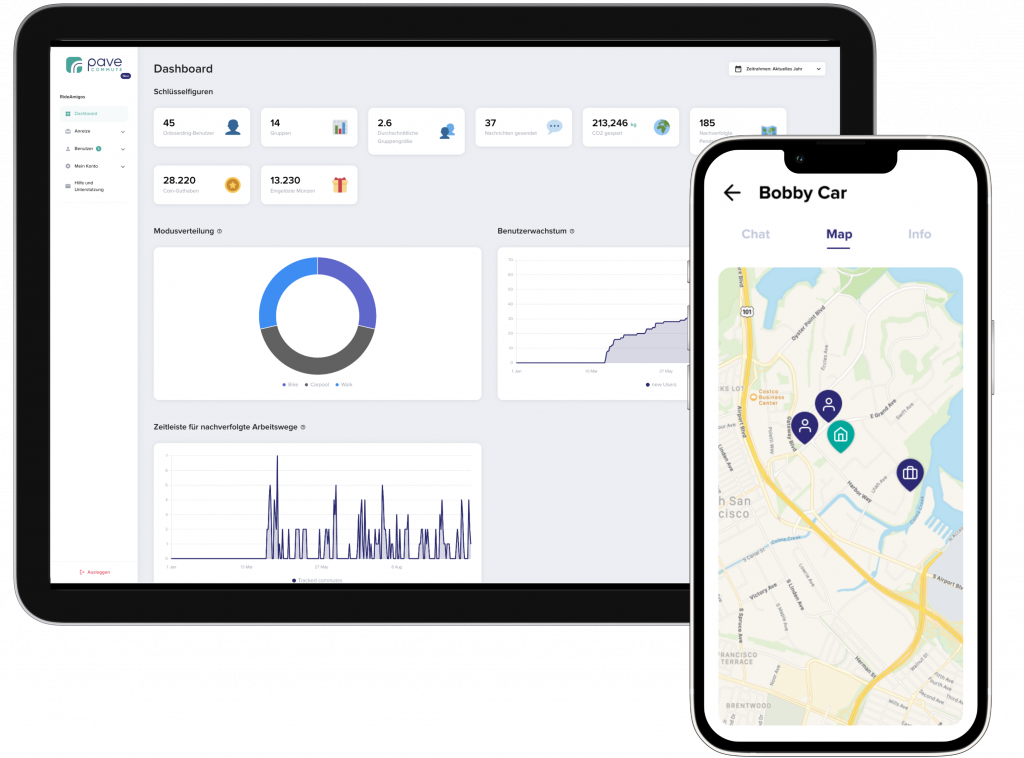Smart commute management programs tend to have the most impact when they generate high levels of participant engagement. One of the best ways to achieve this is to build a social element into the program at the design level. This leverages the “network effect,” which is a behavioral science concept that is just starting to attract attention in the transportation demand management (TDM) world.
Businesses with socially connected workforces benefit in a number of important, and some not-so-obvious ways. Let’s break down the business case for making strategic investments in socially oriented smart commuter programs.
Defining Smart Commuter Programs
“Smart commute management” is more than just a collection of industry buzzwords. It describes an organization-wide commitment to sustainability that emphasizes encouraging team members to make increased use of sustainable alternatives to solo driving.
Smart commutes can include both individual and group trips. In the context of building organizational social networks, group trips have much more relevance.
Examples include:
- Ridesharing and carpooling programs
- Bikepools
- Transit pools
Incorporating these strategies into your commuter programs can encourage positive and supportive interactions among team members who might not otherwise have engaged with one another. Applied on a company-wide scale, these programs can improve social connectedness among team members, helping them network and form new friendships, and feel more engaged with the organization. This, in turn, can lead to a more positive and productive work environment.
The Bottom-Line Benefits of a Socially Connected Organization
High levels of social connectivity among a company’s employees can lead to indirect but significant and highly positive impacts on its bottom line. These impacts derive from three key benefits: improved job satisfaction, heightened organizational resilience, and increased productivity.
Higher Levels of Job Satisfaction
In the early 2000s, experts began to look beyond factors like meaningful work, task diversity, and independence when researching sources of job satisfaction. Instead, some began to hypothesize that environmental conditions had an important but unquantified impact. A landmark 2007 study carried out at Michigan State University confirmed the notion that strong social ties lead to higher levels of job satisfaction. In fact, the researchers who performed the study were surprised to learn just how profound its impact could be.
A 2021 study conducted by the recruiting firm Hays found that nearly half of the 2,000 respondents who participated said undesirable company culture was a key driver in their recent decision to leave a job. Thus, organizations that invest in building positive cultures, in which people genuinely want to participate, put themselves in a position to dramatically reduce employee turnover rates.
Global hiring platform Indeed estimates that it costs around 33% of an employee’s salary to replace them if they leave, to say nothing of the costs associated with leaving a job vacancy unfilled for an extended period of time. That kind of spending can add up very quickly, especially in large organizations whose internal cultures result in high turnover among employees.
Greater Organizational Resilience
Smart commuter programs built around social networking lead to higher levels of organizational resilience. The concept of organizational resilience applies the notion of transportation resilience to enterprises. In essence, it explains how businesses can maintain acceptable levels of operational continuity when confronted with major obstacles and interruptions.
When employees have large and strong social networks, they are better able to source shared modes of transportation when their primary or preferred mode is not available. This improves resilience, reduces productivity losses, and buttresses operational efficiency and effectiveness.
Productivity Improvements
Studies also strongly link job satisfaction and personal happiness with improved productivity. Extensive social ties are a proven source of happiness, as supported by a large and growing body of research-based evidence. Factor in the striking results of this 2019 Oxford University study, which found that happy workers are as much as 13% more productive during their time in the workplace, and you have the recipe for dramatically increased profitability.
Across the board, the science uniformly shows that happy, socially connected employees are essential to strong, healthy, and profitable companies.
Get Started with Pave Commute
Pave Commute is an app-based program for commuters that leverages behavioral science and artificial intelligence to provide each commuter with personalized planning and social support, and rewards them for making smart choices. Launch Pave Commute for your employees with a few clicks. There are plans to fit every type of organization. Start your free trial today!
The team behind Pave Commute provides commute solutions used by top employers and government agencies around the world. Book a free call with us if you want to learn more about applying science-based approaches to the commute.
Sign up your team!
Try Pave Commute with your team free for 30 days. No credit card required.



